Click on images to enlarge
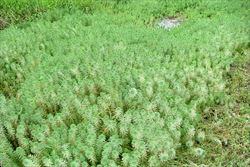
dense infestation (Photo: Sheldon Navie)
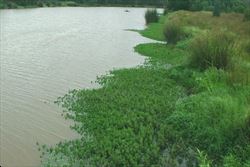
infestation along the margins of a waterway (Photo: Sheldon Navie)
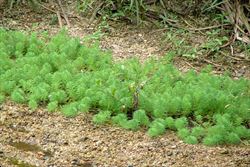
infestation in a dry waterway (Photo: Sheldon Navie)
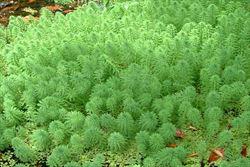
habit (Photo: Sheldon Navie)
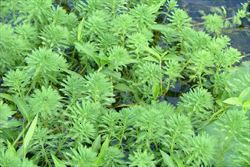
habit (Photo: Sheldon Navie)
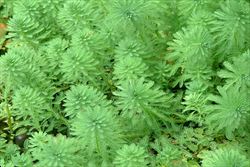
habit (Photo: Sheldon Navie)
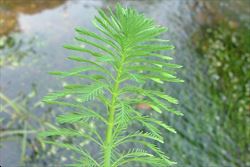
stem with leaves arranged in whorls (Photo: Sheldon Navie)
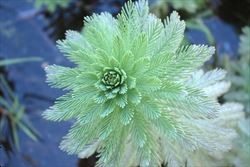
close-up of deeply-divided leaves (Photo: Sheldon Navie)
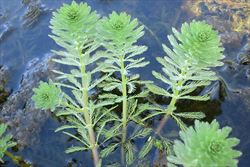
emergent stems with tiny flowers are sometimes borne in the leaf forks (Photo: Sheldon Navie)
Scientific Name
Myriophyllum aquaticum (Vell.) Verdc.
Synonyms
Enydria aquatica Vell.
Myriophyllum brasiliense Cambess.
Family
Haloragaceae
Common Names
Brazilian water milfoil, Brazilian watermilfoil, diamond milfoil, parrot feather watermilfoil, parrotfeather, parrot's feather, thread of life, threads of life, water feather, water milfoil
Origin
Native to South America (i.e. Brazil, Bolivia, Ecuador, Peru, Argentina, Chile and Paraguay).
Cultivation
Parrot's feather (Myriophyllum aquaticum) has been widely cultivated as an aquatic ornamental plant in aquaria and garden ponds. However, it is relatively uncommon in cultivation these days.
Naturalised Distribution
Widely naturalised in the coastal districts of southern and eastern Australia (i.e. in eastern Queensland, in the coastal and sub-coastal districts of northern and central New South Wales, in Victoria and Tasmania, in south-eastern South Australia and in south-western Western Australia). Also occasionally naturalised in inland Queensland.
Naturalised overseas in South Africa, La Réunion, Japan, Europe, New Zealand, the USA and Hawaii.
Habitat
This species is usually found around the edges of bodies of fresh water (i.e. ponds, dams, lakes, etc.), in slow-moving waterways and in drains in sub-tropical and warmer temperate regions.
Habit
A long-lived (i.e. perennial), freshwater, aquatic plant with stems growing 2-5 m long and forming dense mats of vegetation on the water surface. These stems usually emerge up to 30 cm above the water surface.
Distinguishing Features
- an emergent freshwater aquatic plant with stems forming dense mats of vegetation on the water surface.
- its bluish-green or pale green leaves are usually arranged in groups of five or six along the stems.
- these leaves have deeply divided margins and are feathery in appearance.
- its inconspicuous female flowers are borne in the upper leaf forks.
- fruit and seeds are not produced in Australia.
Stems and Leaves
The stems (up to 5 mm thick) are usually green or yellowish-green in colour and either creep across the ground or rising up through up to several metres of water. Roots are often formed at the joints (i.e. nodes) near the base of the stems (i.e. adventitious roots).
The leaves are bluish-green (i.e. glaucous) or pale green in colour and feathery in appearance. These leaves (30-45 mm long and about 15 mm wide) are usually arranged in groups (i.e. whorls) of five or six and are more densely crowded towards the tips of the stems. They are elongated (i.e. lanceolate) or oval (i.e. elliptic) in outline with deeply divided margins. These divisions are regular and form 10-18 pairs of long and narrow (i.e. linear) segments, each about 6-7 mm long.
Flowers and Fruit
Male and female flowers are usually produced on separate plants, however only female-flowered plants are present in Australia. These flowers are inconspicuous (0.5. mm across) and borne singly on short stalks (i.e. pedicels) in the upper leaf forks (i.e .axils). Two small bracts (about 1.5 mm long) surround these flowers which have four whitish or almost see-through (i.e. translucent) 'petals' (i.e. perianth segments) 0.5-1.5 mm long. These 'petals' are actually sepals and true petals are absent. Flowering occurs mostly during spring and summer.
No fruit or seeds are produced in Australia.
Reproduction and Dispersal
Reproduction in Australia is entirely by vegetative means as no viable seeds are produced. Stem fragments readily develop roots and form new plants, while vegetative buds are also produced.
These stem fragments are spread by water movement, boats, vehicles, animals and in dumped aquarium waste.
Environmental Impact
Parrot's feather (Myriophyllum aquaticum) is regarded as an environmental weed in Queensland, New South Wales, the ACT, Victoria, Tasmania, South Australia and Western Australia. It was recently listed as a priority environmental weed in four Natural Resource Management regions.
Legislation
This species is declared under legislation in the following states and territories:
- ACT: C1 - notifiable pest plant (a pest plant whose presence must be notified), and C4 - prohibited pest plant (a pest plant whose propagation and supply is prohibited).
- Tasmania: D - the importation or sale of this species is prohibited and measures to reduce its population in an area, eradicate it from an area, or restrict it to a particular area may be required.
- Western Australia: P1 - trade, sale or movement into the state prevented, and P2 - to be eradicated (throughout the entire state).
Similar Species
Parrot's feather (Myriophyllum aquaticum) is very similar to several native water milfoils (Myriophyllum spp.), including red water milfoil (Myriophyllum verrucosum) and common water milfoil (Myriophyllum papillosum). These species can be differentiated by the following differences:
- parrot's feather (Myriophyllum aquaticum) has emergent leaves that are finely divided into numerous (18-36) segments and are feathery in appearance. These leaves are usually arranged in groups (i.e. whorls) of five or six and are bluish-green to green in colour. Its inconspicuous flowers are borne singly on short stalks in the upper leaf forks (i.e. axils) and only female flowers are present in Australia.
- red water milfoil (Myriophyllum verrucosum) has emergent leaves that are finely divided into several (less than 12) segments and are feathery in appearance. These leaves are usually arranged in groups (i.e. whorls) of three or four and are green to reddish-purple in colour. Its inconspicuous flowers are borne singly in the upper leaf forks and separate male and female flowers are usually produced on the same plant (i.e. plants are monoecious).
- common water milfoil (Myriophyllum papillosum) has emergent leaves that are very thin (i.e. terete), undivided, and finely toothed. These leaves are usually arranged in groups (i.e. whorls) of five or six and are green in colour. Its inconspicuous flowers are borne in small groups in the upper leaf forks and separate male and female flowers are usually produced on the same plant (i.e. plants are monoecious).
Parrot's feather (Myriophyllum aquaticum) can occasionally also be confused with other water weeds such as dense waterweed (Egeria densa), elodea (Elodea canadensis), hydrilla (Hydrilla verticillata), lagarosiphon (Lagarosiphon major), hornwort (Ceratophyllum demersum) and cabomba (Cabomba caroliniana). However, these plants are mostly submerged and only have their flowers above the water surface.

